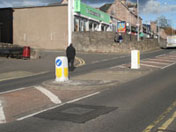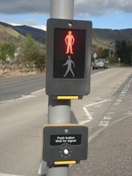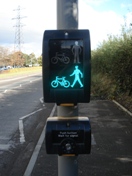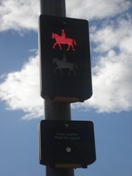Pedestrian Crossings
Pedestrian Crossings
Pedestrian crossings are provided to give people a safer place to cross the road. These crossing points are located at sites where there are high volumes of traffic and pedestrians. Within Clackmannanshire there are several different types of crossings in use. These include:
Uncontrolled crossings
- Dropped kerbs and pedestrian island
- Dropped kerbs only
- General road without any pedestrian facilities
Controlled Crossings
- Zebra
- Pelican
- Puffin
- Toucan
- Pegasus
For more information on each of the crossings, including how to use them, click on the links below.
- Uncontrolled crossings
-

The simplest type of pedestrian crossing is the informal crossing point, which may include dropped kerbs, tactile paving and a traffic island if road width permits. These are generally used in areas where a formal (controlled) pedestrian crossing cannot be justified.
Drivers are not required to stop at an uncontrolled crossing point. The pedestrian must wait at the kerb until there is a suitable gap in traffic to allow them to cross and should only then cross with due care and attention. If there are no crossing facilities a pedestrian should look for a safe place to cross where there is space to reach the pavement on the other side and all directions can be seen clearly. Crossing between parked cars, on a blind bend, or close to the brow of a hill should be avoided. Pedestrians must look all around for traffic and listen. Pedestrians must not cross until there is a safe gap in the traffic and there is plenty of time to cross. Even if traffic is a long way off, it may be approaching very quickly. When it is safe, pedestrians should go straight across the road without running. Pedestrians must keep looking and listening for traffic whilst crossing. - Zebra Crossing
-

Zebra crossings are easily identified by the distinctive black and white stripes painted on the road and the flashing orange belisha beacons. Zebra crossings are controlled crossings where pedestrians have a legal priority over vehicles without the use of traffic signals. This can make them safer than they first appear as the pedestrian must ensure that the traffic has seen them and stopped before crossing the road.
Within Clackmannanshire, Zebra crossings are provided at locations where a signalised crossing point cannot be justified and where the speed of the road is no higher than 30mph. Zebra crossings are difficult to use for those with a visual impairment and for this reason Clackmannanshire Council will never use a Zebra in place of a traffic signalised crossing. Zebra crossings are generally provided in areas where there are people trying to cross a busy road.
- Using a Zebra Crossing
-
Pedestrians wishing to cross at a Zebra crossing must stop at the kerb and wait for the traffic to stop in both directions. When the traffic has stopped the pedestrian should cross whilst still watching for traffic. It is not unknown for cars to overtake those which have stopped to allow a person to cross. If the crossing has an island in the centre of the road, the pedestrian should stop on the island and wait until the traffic on the opposite side of the road stops before continuing to cross. Crossing near the Zebra, but not actually on it, is very dangerous as drivers are more likely to be focusing on the crossing itself and may not see a person crossing elsewhere.
Drivers approaching a zebra crossing should do so with caution, as any pedestrian who steps onto the crossing has priority. Drivers must stop and give way to a pedestrian who has moved onto the zebra crossing and should only start again once all pedestrians have left the crossing. However many pedestrians will wait at the kerb for cars to stop before moving onto the crossing. Drivers must never overtake the moving or stopped vehicle closest to the zebra crossing. Cars must never be stopped or parked on the zig-zag markings at a Zebra crossing, as this reduces the visibility and can put pedestrians at a greater risk.
- Pelican Crossing
-

Pelican crossings are sometimes referred to as Pedestrian Light Controlled Crossings. Pelican crossings can be located on their own or as part of a traffic signal controlled junction. A Pelican crossing uses a pedestrian operated push button to stop the traffic. The pedestrian is signalled when to cross by use of a red and green man on the signal post on the opposite side of the road. When the red man is lit pedestrians should not cross, although it is not illegal to do so.
Pelican crossings provide clear instructions to both drivers and pedestrians of when to stop and when to go. However the disadvantage is that often a pedestrian will push the button and then either cross in a gap of traffic or continue walking down the road. The sequence of the lights will continue as if the pedestrian were still waiting to cross and bring the traffic to a stop. Many Pelican crossings will also have an audible signal to assist those with visual impairments. Staggered crossings are treated as two separate crossing points.
There are only three Pelican crossings within Clackmannanshire, the last of which was installed in 1999. When any Pelican crossing is being replaced, it is replaced with a Puffin crossing.
- Using a Pelican Crossing
Pedestrians wishing to cross at a Pelican crossing should stop at the kerb and press the button. The pedestrian should then wait at the kerb until the green man is shown on the opposite side of the road. When the steady green man shows the pedestrian should check that the traffic has stopped before entering the road. Whilst crossing the pedestrian should continue to watch and listen for other vehicles who may not have stopped at the crossing. When the green man begins to flash, traffic will be signalled with a flashing amber light to start moving if it is safe to do so. For those who have already started crossing they should continue to do so and have a right of precedence to complete their crossing. Any pedestrian who has not yet started to cross should wait at the kerb and push the button.
Drivers approaching a Pelican crossing should behave as with all signal-controlled crossings, the exception being where flashing amber follows the red stop light. Drivers must stop when the red light shows. When the amber light is flashing, drivers must continue to give way to any pedestrians on the crossing. If the amber light is flashing and there are no pedestrians on the crossing, drivers may proceed with caution. Pelican crossings which go straight across the road are one crossing, even when there is a central island. Drivers must wait for pedestrians who are crossing from the other side of the island. This does not apply where the crossing is staggered and controlled by independent signals.
- Puffin Crossing
The majority of controlled crossing points within Clackmannanshire are Puffin crossings. The Puffin crossing (Pedestrian User Friendly Intelligent Crossing) was developed to replace the Pelican crossing. Puffin crossings differ from Pelican crossings as they do not have the flashing green man and flashing amber signal. The red and green man are located just above the push button on the same side as the pedestrian and this encourages pedestrians to face the oncoming traffic while waiting for the green man to show. Puffin crossing also have on crossing detectors to extend the time traffic is stopped to allow all pedestrians to cross.
- Using a Puffin Crossing
Using the Puffin crossing is similar to using a Pelican crossing, except that once the pedestrian moves onto the road they can no longer see the red and green man. This encourages pedestrians to look at the traffic rather than the signal. There is also no need for pedestrians to feel the need to rush when the red man appears, as the on crossing detectors will identify the need for traffic to continue to wait.
Pedestrians wishing to cross at a Puffin crossing should stop at the kerb and press the button. The pedestrian should then wait at the kerb until the green man is shown on the signal post next to them. When the green man shows the pedestrian should check that the traffic has stopped before entering the road. Whilst crossing the pedestrian should continue to watch and listen for other vehicles who may not have stopped at the crossing. Any pedestrian crossing should not see the red man when it appears and if they do they should continue to cross at a normal speed. If the red man is shown, any pedestrian who has not yet started to cross should wait at the kerb and push the button.
Drivers approaching a Puffin crossing should behave as with all signal-controlled crossings. Drivers must stop when the red light shows. Puffin crossings which go straight across the road are one crossing, even when there is a central island. Drivers must wait for pedestrians who are crossing from the other side of the island. This does not apply where the crossing is staggered and controlled by independent signals.
- Toucan Crossing
The Toucan (two can cross) crossing is a shared signal controlled crossing designed for use by pedestrians and cyclists. Toucan crossings are very similar to Puffin crossings, but they are wider and have a red and green cycle as well as the red and green man. Unlike Pelican and Puffin crossings, cyclists can legally cycle across the road.
Within Clackmannanshire there are two Toucan crossings. These are generally located where a cycle route crosses a busy road, or where cyclists may be expected.
- Using a Toucan Crossing
Pedestrians or cyclists wishing to cross at a Toucan crossing should stop at the kerb and press the button. The pedestrian or cyclist should then wait at the kerb until the green man and cycle is shown on the signal post next to them. When the green man and cycle are shown the pedestrian or cyclist should check that the traffic has stopped before entering the road. Whilst crossing the pedestrian or cyclists should continue to watch and listen for other vehicles who may not have stopped at the crossing. Any pedestrian or cyclists crossing should not see the red man or cycle when it appears and if they do they should continue to cross at a normal speed. If the red man and cycle is shown, any pedestrian or cyclist who has not yet started to cross should wait at the kerb and push the button. Cyclists should take care when crossing to avoid pedestrians also using the crossing.
Drivers approaching a Toucan crossing should behave as with all signal-controlled crossings. Drivers must stop when the red light shows. Toucan crossings which go straight across the road are one crossing, even when there is a central island. Drivers must wait for pedestrians and cyclists who are crossing from the other side of the island. This does not apply where the crossing is staggered and controlled by independent signals.
- Pegasus Crossing
The Pegasus crossing is based on the Puffin crossing with separate push buttons and enclosures for horses with riders. The pedestrian area is the same as with a Puffin crossing with a kerb side button and red and green man symbol. The Pegasus crossing has an additional traffic signal pole and enclosed area, separate from the pedestrian crossing area, with a red and green horse with rider symbol. The push button is located 2m from the ground to allow a rider to call the traffic to a halt without dismounting.
There is one Pegasus crossing in Clackmannanshire on the A908 at Devon Village, located near the Devon Way and the local livery.
- Using a Pegasus Crossing
Pedestrians wanting to cross at a Pegasus crossing should stop at the kerb and press the button. Any horses with riders wishing to cross should move to the enclosed area and stop at the kerb and press the button. The pedestrian or horse with rider should then wait at the kerb until the green man and horse with rider is shown on the signal post next to them. When the green man and horse with rider are shown the pedestrian or horse with rider should check that the traffic has stopped before entering the road. Whilst crossing the pedestrian or horse with rider should continue to watch and listen for other vehicles who may not have stopped at the crossing. Any pedestrian or horse with rider crossing should not see the red man or horse with rider when it appears and if they do they should continue to cross at a normal speed. If the red man and horse with rider is shown, any pedestrian or horse with rider who has not yet started to cross should wait at the kerb and push the button.
Drivers approaching a Pegasus crossing should behave as with all signal-controlled crossings. Drivers must stop when the red light shows. Pegasus crossings which go straight across the road are one crossing, even when there is a central island. Drivers must wait for pedestrians or horse with rider who are crossing from the other side of the island. This does not apply where the crossing is staggered and controlled by independent signals.
Drivers must take extra care when approaching a Pegasus crossing and must never sound the horn or rev the engine as this may scare a horse. Drivers must always be aware that some animals may be led or ridden on the road. When overtaking a horse and rider the driver should position the car as far from the horse as possible, ideally on the other side of the road if safe to do so. If another car is approaching in the opposite direction, drivers must slow down and allow plenty of space between the horse and rider in front, before moving out to pass when it is safe to do so.
- What are on crossing detectors?
-

Special sensors (on crossing or intelligent detectors) are located on the traffic signal poles at Puffin, Toucan and Pegasus crossings to detect pedestrians, cyclists or horse with rider waiting to cross once the button has been pressed. The sensors detect both pedestrians waiting to cross and those crossing. These detectors will cancel any calls for traffic to stop that are no longer required, i.e. if the pedestrian has walked away or crossed in a gap of traffic. These sensors also detect pedestrians that are crossing and ensures that the traffic is signalled to stop until all pedestrians have finished crossing. These sensors determine the length of time given to pedestrians crossing and are not fixed as in the case of Pelican crossings. It is therefore important that any pedestrians waiting to cross remain beside the push button box while the red man is showing.
- Assistance for people with disabilities
All formal pedestrian crossing points should have dropped kerbs to assist those with mobility impairments. Controlled crossing points will have red tactile paving and beige coloured tactile paving at uncontrolled crossing points. Tactile paving is a knobbly raised surface to let people who have a visual impairment find the crossing point and kerb.
Tactile cones are located under the red and green man signal box on Puffin and Toucan crossings, these cones rotate when the green man is shown and lets those pedestrians with a visual and/or hearing impairment know that the traffic has been signalled to stop.
There is also often a bleeping sound to indicate that the steady green man is lit on all signal controlled crossings. The audible bleeping sound is occasionally switched off in locations where it is considered a nuisance to adjacent houses. At crossings with an audible bleeping sound, the audible sound is either switched off or the volume is decreased in the evening and during the night.
- How to report a problem with a Crossing?
Any problems with a pedestrian crossing should be reported to Clackmannanshire Council. This can be done through Report It or by telephoning 01259 450000. The Council have a contract with SIEMENS to fix any problems with both traffic and pedestrian signals.
- Crossing at railway level crossings
-
Pedestrians must never cross or pass a stop line when the red lights show, if an alarm is sounding or the barriers are being lowered. The tone of the alarm may change if another train is approaching. If there are no lights, alarms or barriers Pedestrians must stop, look both ways and listen before crossing. A tactile surface comprising rounded bars running across the direction of pedestrian travel may be installed on the footpath approaching a level crossing to warn visually impaired people of its presence.
Related Pages
For Further Information Contact
Roads & Transportation
Kilncraigs, Greenside Street, Alloa, FK10 1EB
Tel: 01259 450000
Email: roads@clacks.gov.uk


